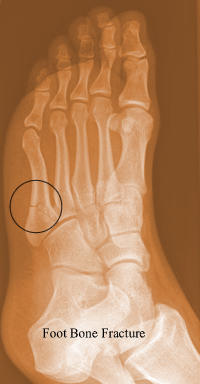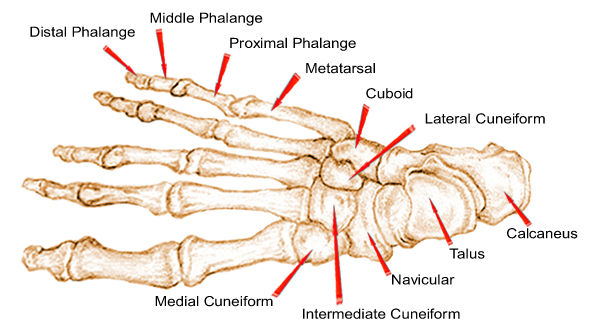Foot Fractures
You may have fractured a bone in your foot and not even realized it.
There are two common types of bone fractures in your feet. Hairline stress fractures and traumatic fractures.
Sometimes a fracture of one or more metatarsal bones in your foot can go unnoticed for weeks. You may not even feel any pain. In most cases, a stress fracture will only really show up in an X-ray, so we do advise talking to your doctor to confirm your thoughts. .
You will notice the traumatic ones. They are very painful, cause swelling and inflammation, and in some cases, can deform the foot into unnatural positions.

Stress Fractures
Stress fractures are tiny little hairline cracks in bones. Some hairline fractures are straight, while other are spiral in nature. These tiny cracks are from excessive pounding, twisting and repetitive actions often associated with athletic activities.
Hairline stress fractures are not to be taken lightly, as they can develop into a more severe situation. Several repeated stress fractures will weaken your foot and make it susceptible for more severe traumatic fractures.
Traumatic Fractures
Foot bone fractures from a blow, impact or accident are much more obvious. Traumatic fractures are very painful and often associated with pain and swelling. If the skin is broken, the injury is susceptible to infections and will need immediate medical attention. Larger breaks of the foot bones often require splinting and casting for stabilization.
Bones of the Foot
There are five Metatarsals in each foot. These bones are the ones that are most often broken or fractured.

Far Infrared Socks for foot pain relief
Prolotex™ Socks do help to reduce aches and pains caused by tiny stress fractures in the bones your feet. And good news! All you have to do, is wear them.
Women going through menopause and people with osteoarthritis can easily break a bone in their foot. Osteoarthritis weakens the bones, making them fragile.
If you are a runner or are active in sports, wearing Prolotex™ Infrared Socks in your sports shoes will help to reduce stress to the bones, and aid in preventing bone injuries.
FIR Therapy Socks speed bone healing
Yes, it's true! Far Infrared rays have been shown to increase cellular activities, thereby speeding up the body's ability to heal itself. Prolotex™ FIR Socks can do just that!
Now... if you have a cast on, the socks may not fit. We recommend that you wear Prolotex™ Infrared Socks on a regular basis, as soon as your cast is removed. If your foot has been in a cast for several weeks, the muscles, tendons and tissues will have become a bit stiff. FIR socks will safely and gently help increase the flexibility of the tendons in your feet and ankles.
FREE Tips To Help Prevent Bone Fractures
- Regular steady exercise so that your body has a chance to build up strength. Increasing bone density takes time.
- Eat a healthy diet and keep your cells hydrated by drinking adequate healthy liquids.
- Take a bone density test... especially if you in your 50's to 70's. Maybe you need to take more calcium and vitamins to strengthen your bones.
- Take a bit of extra time to evaluate your environment for possible safety hazards. Many accidents and injuries to your feet can be avoided, if you are adequately prepared for action.
- Wear a fresh, clean pair of Prolotex™ Far Infrared Socks every day to help improve the micro-circulation and strength of the bones in your feet.
- Exercise on moderately forgiving surfaces, rather than hard concrete. A rubber track is better for your bones.
- Take good care of your feet so that they will let you keep walking.

